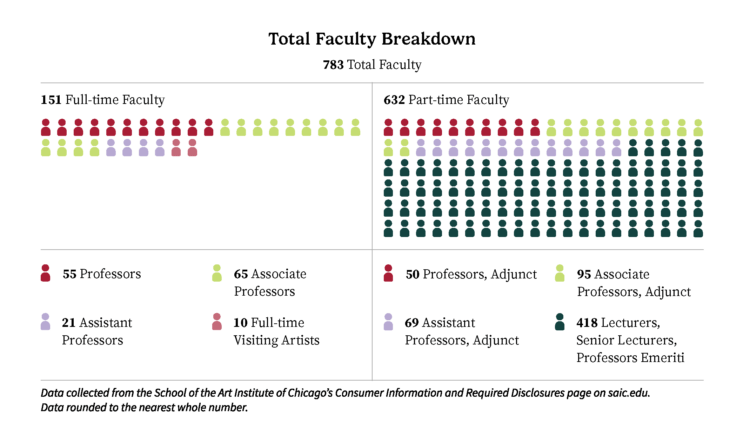Correction 6/3/25: Danny Floyd is an an assistant professor, adjunct; not an assistant professor.
That class you’ve been trying to get into since you were a freshman? Or the one that changed the way you think about art? There’s an 80% chance those classes were taught by a part-time faculty member, and a 53% chance it was taught by a lecturer.
“Part-time faculty bring a wealth of knowledge. Most continue honing their artistic craft, so they can teach from real-world experiences. They also allow us to offer niche practices and classes. For instance, we can offer classes like neon and letterpress courses because we can seek experts in those fields,” said Bree Witt, interim vice president for marketing and communications.
Part-time faculty at the School of the Art Institute of Chicago includes lecturers and adjuncts. Lecturers, however, have no benefits, only one representative within the faculty senate, no long-term contracts, and are paid less than permanent faculty. Despite being the faculty majority, lecturers are in the most vulnerable position and are more likely to leave academia.

“You are not guaranteed to stay here or have a career here indefinitely as a lecturer,” said
Danny Floyd, an assistant professor, adjunct in visual and critical studies, a faculty senator, and a member of the bargaining team of the Art Institute of Chicago Workers United’s Non-Tenure Track Faculty branch.
As the NTT faculty union continues to negotiate with the administration, the NTT’s primary demands are health care benefits, job stability, grievance processes, and pay parity with full-time faculty.
At many universities, adjunct faculty are at the bottom of the faculty ecosystem, but at SAIC, adjuncts sit above lecturers. For students, the multiplicity of faculty positions can complicate understanding the roles of faculty.
At SAIC, full-time faculty are expected to teach six courses a year. Adjunct faculty do not have a maximum number of courses they can teach. Lecturers are only allowed to teach three courses a year. (Lecturers hired before 2017 were grandfathered into a course load that tops out at five.) Winter and summer semesters do not count toward any position’s total course numbers.
Full-Time Faculty
Of the 783 total faculty at SAIC, 151 are full-time — fewer than 20%.
“Part-time faculty are hired solely for their teaching expertise, while tenured faculty are also hired for their expertise and excellence in creative or research practice,” said Witt.
There are three tiers of full-time tenure-track faculty at SAIC: assistant professors, associate professors, and full professors. Each jump in rank comes with additional pay and responsibilities. Tenure is, at its core, the result of a six-year process to achieve permanent employment, partially through academic excellence.
Assistant professors, according to the 2024 faculty handbook, are regular full-time faculty members with one to six years of teaching or professional experience. They are expected to hold an MFA or have “comparable professional achievement.” This is the entry rank of full-time faculty.
Associate professors have the same expectations as assistant professors, but they also are expected to have “made an unusual contribution to the school in terms of teaching, creative activity, productive scholarship, or other educational service,” according to the handbook.
Professors, also called full professors, are the highest faculty position. The handbook emphasizes that full professors are master teachers with significant reputations and noteworthy accomplishments. The handbook also states that department chairs and other similar titles such as chair of faculty and faculty liaison are “considered as having regular full-time faculty status regardless of actual teaching assignment and salary.”
While not on the tenure track, a fourth category of full-time faculty is visiting faculty, also called visiting artists. These are usually short-term year-long contracts.
Part-Time Faculty
Faculty not tenured or on the track to tenure are considered part-time faculty, regardless of how many courses they teach. They usually receive contracts of two to three years, and the benefits they receive vary depending on whether they are an adjunct or a lecturer.
Part-time faculty also have an Additional Compensation (“Day Rate”) Policy that gives them eligibility to be paid $300 for obligations such as critique panels, graduate portfolio reviews, and departmental student exhibitions. For obligations under 4.5 hours, they are paid $150.
Ranked part-time faculty are adjuncts. Ranking means that similar to full-time faculty, adjuncts are divided into assistant professor, adjunct; associate professor, adjunct; and professor, adjunct. This affects pay, status, responsibilities, and contract length.
Lecturers are considered unranked part-time faculty. Unlike the other positions, lecturer is not fully defined, but there is a large gap between lecturer and assistant professor, adjunct — especially when it comes to benefits.
The promotion process from lecturer to assistant professor, adjunct is a hurdle that most won’t ever reach. It took Floyd ten years to be promoted from a lecturer to an assistant professor, adjunct, making him part of a small group. He described the situation as a bottleneck.
“This promotion from lecturer to adjunct is an extraordinarily grueling process. It’s one of the most contentious processes at the school in which far more people are deserving than will ever get the promotion each year,” said Floyd.

Data collected from the School of the Art Institute of Chicago’s Consumer Information and Required Disclosures page on saic.edu.
Information collected from articbenguide.com, SAIC’s benefit guide and overview website.







